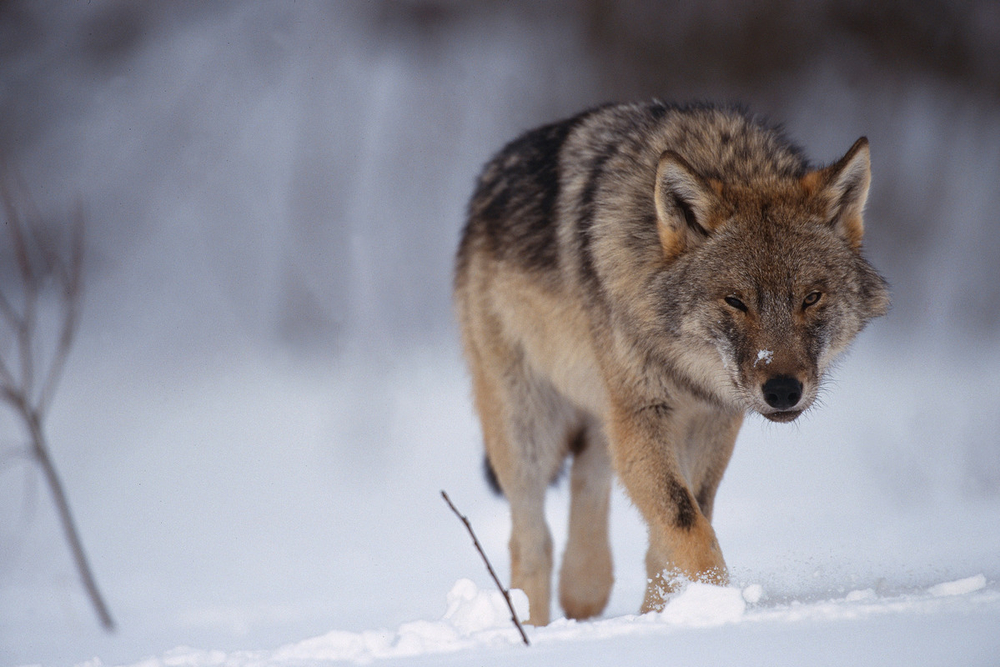ConnectGREEN - Safe ecological corridors must urgently be established as wolves are at once both protected and hunted
14-01-2019
Wolf hunting season in Slovakia lasts from November 1 until January 15. Hunting wolves is prohibited in NATURA 2000 protected areas, but if the animals cross the boundaries of these zones, the law allows them to be killed. The problem is that wolves do not make the distinction between Natura 2000 and other areas and roam for great distances. In fact, research has proven that wolves may migrate up to 2000 km. Therefore, safe ecological corridors between protected areas are essential.

©Thomas Hulik/WWF Slovakia
“Not all protected sites fulfil wolves’ demands. Many areas should be extended or at least connected by safe ecological corridors which can protect wolves during migration. Now we protect them at den sites, but they are hunted when they wander outside the national parks in search of prey. It is as if we would protect wolves in the living room, but kill them if they stray into the kitchen,” says Jerguš Tesák, expert from WWF Slovakia.
Slavomír Finďo from the State Nature Conservancy of the Slovak Republic confirms: “There are 84 NATURA 2000 sites in Slovakia where the wolf is protected. However, those sites were proclaimed in 2005 when our knowledge about their migration demands was insufficient. For conservation purposes, wolves require tens of thousands of hectares. Some large-scale areas meet that criteria, but smaller sites don’t contribute to our conservation aims. Wolves can cross them within a few minutes. We must enlarge them and connect them with ecological corridors.”
Maintaining and improving the ecological connectivity between natural habitats, especially between Natura 2000 locations, is the main aim of the European ConnectGREEN Project. The project links various partners from 7 European countries including a number of organisations from Slovakia such as WWF Slovakia, the State Nature Conservancy of the Slovak Republic, the Slovak Environment Agency and spatial planners from the Slovak University of Technology in Bratislava.
Poaching is a problem
Hunting season in Slovakia lasts from November 1 until January 15, during which no more than 70 wolves are allowed to be shot. Until 1995, there was no restriction on hunting wolves at all. Wolf hunting was completely banned in 1996-1998. All restrictions were once again removed between 1998-2006, and the extended annual hunting season lasted from September until February. A quota was reintroduced in 2009, and the hunting season was shortened. However, poaching still remains a huge problem. “Even between 1996-1998 when wolf hunting was banned, hunters killed 154 wolves. It means they either didn’t notice the ban or they just didn’t respect it. I assume that even now there are more wolves killed illegally than legally,” says Slavomír Finďo.

© Staffan Widstrand / WWF
Jerguš Tesák from WWF Slovakia says: “Nowadays, hunters in Slovakia not only have to report the number of wolves killed, but also have to notify a State Nature Conservancy officer. Since this rule was adopted, the number of wolves reported killed dropped from about 150 to 27 in 2013/14. Such a dramatic decline has led to the opinion that wolves have been hunted through the entire year, but just reported during the hunting season. Even now while the quota permits 70 wolves per season, only 40-50 are reported. Furthermore, a question remains concerning how hunters respect another rule – not killing an alpha pair. If an alpha pair is killed it can lead to the disintegration of a pack, which in turn can lead to former members of the pack searching for easier pray such as sheep on poorly protected farms.”
See here a video with a pair of wolves in Muránska planina National Park.
Slavomír Finďo supports the opinion that hunting of wolves can affect a whole pack. “Telemetric research in the Low and High Tatras proves that wolves wander between ten or even more hunting grounds. Consequently, hunters can even kill a whole pack.”
ConnectGREEN is a 3-year project that will identify ecological corridors by using a new methodology and maps of target species, core areas, ecological corridors and critical barriers in 4 pilot areas will be prepared. Moreover, a set of recommendations will be developed together with spatial planners to avoid or minimise fragmentation of ecological corridors and Natura 2000 sites.
